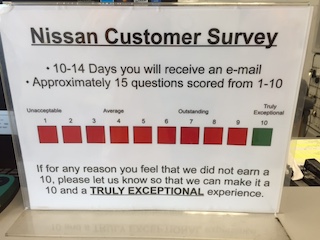How not to improve your company’s Net Promoter Score

HBR published an article called “How to Improve Your Company’s Net Promoter Score.” What a misguided goal!
About the quest to improve NPS
A little background here. Bain fellow Fred Reichheld invented Net Promoter Score (NPS) decades ago. In NPS, you ask your customers, “How likely is it that you would recommend this product or company to a friend or colleague?” with answers on a scale of 0 to 10. Count the percentage of 9’s and 10’s (Promoters), subtract the percentage of 0 to 6’s (Detractors), and you have your Net Promoter Score. Reichheld showed that high Net Promoter Scores were correlated to growth in his book The Ultimate Question.
But there are two problems with a quest to improve your Net Promoter Score.
First, NPS is a flawed measure. As customer experience expert Jared Spool has pointed out, it’s blunt and unstable. And he’s far from the only critic.
But put that aside. Clearly NPS is correlated in some way with happier and more satisfied customers. Does it follow that improving NPS will improve your company’s customer experience?
Of course not.
Suppose I offer you a survey, but promise to send you $50 if you rate my company a 9 or a 10, and to send you a dead weasel in the mail if you rate me a 6 or below. My NPS would soar! That’s a foolproof way to improve Net Promoter Score.
The score is the diagnostic. The goal is to improve the company, not the score. I don’t want SAT scores to improve because students take SAT prep courses, I don’t want unemployment numbers to improve because people have given up looking for work and are no longer counted, and I don’t want NPS to improve because I figured out a way to game the system.
What is the HBR article actually suggesting?
Let’s look closer to see if the real problem here is just that the article has a misleading title. Here are some excerpts of what Thales S. Teixeira and Renato Mendes recommend.
There is a sure-fire way to increase your company’s Net Promoter Score (NPS) or the likelihood that customers will recommend you to others. There’s also a sure-fire way to learn about your operational vulnerabilities using customer surveys. The key in both cases is to give customers the chance to evaluate you at exactly the right moment.
The lede is a problem: improving the NPS should not be the goal. And yes, it’s true that surveying customers at the right moment will improve your score. That will tell you only that they’re happy at one moment.
[C]onflating all of the customer’s experiences into one summary judgment leads to lost opportunities. It can be instructive to think about what steps the customer goes through in the course of acquiring, using, and disposing of products and services (what we call the customer value chain) and to consider asking them to fill out the form at a different point in their journey.
I thought a value chain had to do with suppliers, manufacturers, distributors, and retailers adding successive value to a product that someone eventually consumes. Apparently Teixeira and Mendes have a different definition of value chain from everybody else.
But this passage gets to the heart of the recommendation, which is that you survey customers throughout the process, not just at the end, to figure out where they are happy with you and where they are unhappy.
Why? Well, in addition to learning more about the customer experience, there is this:
If you want your customers to do something positive on your behalf, like review your business online, make a recommendation, repurchase, subscribe, or sign up for a mailing list, the ideal moment is just after their most positive experience (which will often be when they’ve interacted with the best that your business has to offer). Why wait for the end of the experience, particularly if something negative may occur? It makes sense to do it immediately after the highest average moment of satisfaction. (You will only know where that is after measuring satisfaction at various points in the customer value chain.)
Hmm. People are more likely to recommend you after they experience something positive. Nice to know.
The value of this article is in its recommendations to understand the full customer experience by measuring it throughout. If you use an instrument less crude than NPS, that would be even better. And if you added insights from other sources (such as ethnographic research, careful tracking of online behavior and Web analytics, and journey mapping) you could get even smarter.
Certainly, you can improve recommendations if you know where people are happy. And you can reduce defections if you figure out where they are unhappy. So you should measure where those points are.
This seems like a pretty basic insight to me. And it’s got very little to do with “Improving Net Promoter Scores.”
I’m sure there is a lot more to Teixeira’s company Decoupling.co and his insights. But this article and its misleading title aren’t doing him much good. I wonder where HBR articles appear in his customer value chain?
Knowing your customer’s happiness and where you can improve is certainly a worthy goal, but if I’m asked at every step of my journey how things are going, chances I’m going to get pretty damn annoyed with all of the “How are we doing?” and all of the extra steps just to get to my end goal. Especially if I don’t get anything in return.